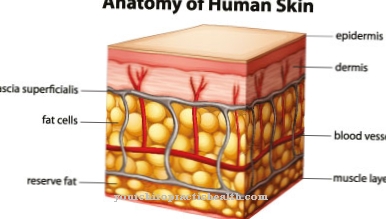Of the Microphthalmos affects the eye and occurs whenever both or one of the eyes are abnormally small or underdeveloped. In most cases, the phenomenon is congenital and occurs, for example, in the context of various malformation syndromes. The therapy is limited to the prosthetic fitting and thus the cosmetic correction.
What is microphthalmos?

© vecton - stock.adobe.com
Various malformations mainly affect the eyes. A malformation of the eyes is the so-called Microphthalmos. This phenomenon occurs whenever a patient's eye is abnormally small. The microphthalmos is innate. Not only an unusual size, but also a rudimentary eyeball is called a microphthalmos. The phenomenon either affects only one eye unilaterally or occurs bilaterally in both eyes.
The phenomenon is sometimes also called microphthalmia with the German version of the term. In the context of various malformation syndromes, the underdevelopment of an eyeball can occur symptomatically, for example in trisomy 13. Microphthalmia is congenital in the majority of cases and therefore rarely occurs as an acquired variant.
The anophthalmos is to be distinguished from the phenomenon. In the context of an anaphthalmos, one eye is either not created at all or is reduced to a few remains. The microphthalmos is assigned to the so-called inhibition malformations.
causes
The cause of microphthalmia is to be found in genetics. Mutations can cause the phenomenon, for example, in trisomy 13 and the so-called Peter-Plus-Syndrome. The mutations are accompanied by a disturbance in the morphogenetic development of the eye. Often there are other inhibitory malformations accompanying the mictophthalmos, such as the coloboma in the sense of a gap in the iris, which can also be traced back to developmental disorders.
Together with other inhibition malformations, for example, microphthalmos characterizes Delleman syndrome. Inhibitory malformations may be induced by thalidomide. Other triggers for the deformities can be infection during early pregnancy. In this context, rubella, cytomegaly or toxoplasmosis should be mentioned in particular.
In the context of malformation syndromes, apart from trisomy 13 and the Peter Plus syndrome, microphthalmos is mainly present in Aicardi syndrome and Pätau syndrome. In extremely rare cases, the phenomenon is acquired and then occurs in the context of diseases such as retrolental fibroplasia, endophthalmitis or after eye injuries.
Patients with microphthalmos have an underdeveloped eye with a small eyeball on either side. All other symptoms depend on the cause of the phenomenon. In malformation syndromes, for example, there are many other malformations apart from microphthalmos. Congenital microphthalmos does not cause pain.
Acquired forms can be painful in the acute phase. In most cases, the physiology of the affected eye is not affected by the phenomenon. Nevertheless, the microphthalmos is in part associated with extraordinary farsightedness.
In addition to the developmental disorder, there may be a cataract of the same eye. The coloboma is also associated with microphthalmos. If the physiology of the eye is affected by the phenomenon, the patient's eyeball will sometimes straighten sideways or twist.
Symptoms, ailments & signs
A microphthalmos is characterized by an exceptionally small eye, which, however, often causes only minor discomfort. Mostly it is a congenital malformation of the eyes. Therefore, the diagnosis can usually be made immediately after birth. Sometimes the eye is not even drawn. Then there is talk of anophthalmos.
Microphthalmos can affect both or just one eye. In addition to the congenital forms, there are also acquired forms of the disease. This can especially happen with severe eye injuries or certain eye diseases in which one or both eyeballs are completely lost. With a microphthalmos, the physiology of the affected eye is usually completely intact.
In most cases, however, pronounced farsightedness is observed. Other malformations and eye diseases are also possible depending on the respective causes. This often leads to a clouding of the lens of the eye (cataract). This can reduce the [impaired vision of the eye]].
A so-called coloboma is often observed as a malformation. A coloboma is a gap that can affect the lens, eyelid, or choroid of the eye. The formation of a gap is not characterized by uniform symptoms. Sometimes it even remains asymptomatic. In severe cases, however, there is a risk of blindness in the affected eye.
Diagnosis & course of disease
Microphthalmos can be recognized by a doctor at first glance. The diagnosis is therefore made exclusively by visual diagnosis. Nevertheless, further examination procedures may be necessary as part of the diagnosis, especially to determine the cause. Most malformation syndromes can be easily diagnosed on the basis of the characteristic symptom complexes.
For others, a molecular genetic analysis can be useful. The prognosis for people with microphthalmos depends on the specific cause. In particular, the acquired microphthalmos in the context of certain diseases can cause the affected eye to go blind.
Complications
Due to the microphthalmos, those affected usually suffer from various malformations. These lead to considerable restrictions in everyday life and enormously reduce the patient's quality of life. Not infrequently, microphthalmos can also lead to complete blindness.
Especially in young people, sudden blindness can lead to significant psychological complaints or to depression. In children, too, blindness leads to severe restrictions in the child's development. Furthermore, the parents are also affected by the symptoms of microphthalmos and often suffer from psychological complaints or depression. Before going blind, various visual problems usually appear, so that patients suddenly suffer from farsightedness.
Treatment of microphthalmos is carried out with the help of antibiotics. It usually leads to success. However, most of those affected still lose sight of the affected eye. This cannot be restored, so that those affected have to live with restrictions their entire life. The life expectancy of the patient is not reduced. In the treatment itself, there are also no particular complications.
When should you go to the doctor?
Due to the visual abnormalities in the face, the microphthalmos is noticed immediately after birth and given medical attention. In the case of an inpatient birth, the nurses and doctors present take over the first care of the newborn. It is examined intensively after the birth and checked for irregularities. Parental intervention is not required in these cases. If the birth takes place in a birthing center or a home birth takes place, the obstetricians or midwife present take over the task of the initial examination. As soon as peculiarities are noticed, a doctor or an ambulance service is informed. Here, too, the baby's parents do not have to be active, as the tasks involved are taken over by trained staff.
If you have a sudden birth without the presence of a doctor or midwife, you should contact an emergency doctor or go to the nearest hospital as soon as possible. Microphthalmos is characterized by an unusually small eye shape. The malformation of the eyes can also be recognized by laypeople and should be presented to a doctor as soon as possible. Various medical tests are necessary to allow a diagnosis to be made. Visual disturbances or irregularities in sight are also signs of an existing illness. As soon as these are noticed in the growing child, they should be examined and treated by a doctor.
Therapy & Treatment
Treatment for microphthalmos depends on the cause. If endophthalmitis is present, treatment consists primarily of giving high-dose broad spectrum antibiotics immediately. According to the antibiogram, it may be necessary to switch to antibiotics that are more effective. The drug should be selected depending on the detected germs.
Some active substances can be injected intravitreally. Glucocorticoids are suitable as a complementary therapy. If the causative disease can be cured in time by antibiotics and glucocorticoids, there is usually no function-impairing microphthalmos. However, the prognosis is unfavorable, especially in the context of endophthalmitis. People often lose sight of the affected eye.
The microphthalmos can then only be corrected cosmetically, but not functionally. Also in the context of malformation syndromes, the cause of the microphthalmos cannot be cured. The malformation has already taken place. If it affects the function, this impairment cannot be reversed afterwards. However, symptomatic approaches are available for the cosmetic impairments caused by microphthalism.
In most cases, the patients are fitted with prostheses. Due to the developments in today's prosthetics, others hardly notice the microphthalmos or not at all. In the meantime, a highly hydrophilic hydrogel expander is often used to adequately supply prostheses, so that a prosthesis can be supplied in the first few months of life.
You can find your medication here
➔ Medicines for eye infectionsOutlook & forecast
A prognosis is intended to inform a patient about what to expect in the future. Statistical surveys form the basis for this. Unfortunately, because of the comparatively low incidence, no precise prognoses for microphthalmos are available. In principle, however, a good outlook can be assumed. The ability to work and individual possibilities are rarely restricted. Last but not least, the cause is also relevant for such optimism. In contrast to quality of life, life expectancy is generally not reduced.
If the microphthalmos is due to a genetic pathology, it is difficult to make any statements about future development. In general, early treatment has a positive effect on the condition. This prevents the loss of eyesight and disorders of facial symmetry.
Loss of sight is definitely possible. This results in severe restrictions. Occupational disability is usually inevitable. Those affected can then only correct the microphthalmos cosmetically. In practice, however, timely therapy for the acquired form proves to be problematic for ophthalmologists. That's because the disease was unpredictable. Therapy approaches cannot therefore be initiated in good time.
prevention
Mothers may be able to prevent congenital microphthalmos by protecting themselves from rubella before pregnancy. However, not all forms of the genetic variant can be extensively prevented. The acquired forms of microphthalmos cannot be successfully prevented either, since infections of the eye cannot necessarily be foreseen.
Aftercare
Follow-up care cannot aim to prevent microphthalmos from recurring. This is because there is no cure for the disorder. Microphthalmos usually has genetic causes and is already present in newborns. In addition, accidents or serious illnesses can cause the typical symptoms.
Follow-up care should primarily make everyday life easier. In order to determine the extent of the eye impairment, doctors carry out extensive examinations of the organ of vision. The extent of the disease can also be seen through x-rays. A missing eye is usually replaced by a prosthesis. Since children are still growing, this cosmetic product should be adjusted regularly.
Suitable facilities such as an eye socket are not always available. There are also challenges beyond appearance. The limited perception can be addressed in a therapy. It's about coping with everyday life as independently as possible, despite the limited vision. Many of those affected suffer from mental disorders as they get older. Stress and the fear of rejection can be reduced in psychotherapy. Sometimes discussions in a self-help group also help. The aftercare therefore primarily pursues cosmetic and emotional goals.
You can do that yourself
In addition to medical therapy, some self-help measures and aids can be used with a microphtalmus. First of all, however, it is important to start medical treatment as early as possible and have the course of the disease closely monitored by a doctor. The earlier therapy is given, the less likely it is to lose sight. Parents who notice an unusually small eye in their child should speak to a health professional.
However, this does not always completely correct the cosmetic abnormality. That is why we recommend long-term therapeutic advice. Younger people in particular suffer from the aesthetic flaw and withdraw from social life. If the child is bullied or marginalized, the responsible teacher should be spoken to. The only way to compensate for the reduced eye and the deteriorated eyesight is to wear glasses with a correspondingly high prescription. Appropriate glasses should be worn as early as possible, as this can at least reduce possible long-term effects.
Should there be eye problems or psychological sequelae of the malformation in later life, a doctor should be consulted.

.jpg)


.jpg)
.jpg)
.jpg)






.jpg)

.jpg)
.jpg)











.jpg)